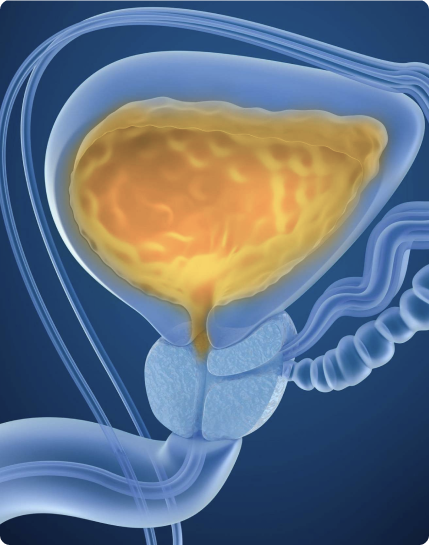Overactive Bladder (OAB)

Overactive bladder (OAB) is a condition characterized by urinary urgency, potentially leading to involuntary loss of urine. These symptoms may appear individually or in combination. OAB is different from stress urinary incontinence, a condition when you leak urine while sneezing, laughing, or other physical efforts.
OAB is diagnosed after excluding bladder pathologies, such as stones, infections, and tumours. It is a very common disorder, affecting 1 in 7 people over the age of 40 years. Women are more likely than men to experience such symptoms due to changes in estrogen and weakened pelvic floor muscles after menopause, pregnancy, and/or menstruation. In men, OAB symptoms usually occur alongside a chronic bladder blockage due to an enlarged prostate.
Overactive Bladder (OAB) SYMPTOMS
Consult your urologist if you are experiencing any of these symptoms, especially when they are causing significant disruption to your daily life and work:
- a sudden compelling desire to pass urine that is difficult to defer (urgency)
- involuntary loss of urine (urgency incontinence)
- frequency in urination (more than eight times a day)
- nocturia (waking up two or more times in the night to urinate)
Causes of Overactive Bladder (OAB)
OAB is caused by the muscle surrounding the bladder contracting spastically, resulting in high bladder pressure and the urgent need to urinate.
In some conditions such as spinal cord injury, stroke, Parkinson’s disease, multiple sclerosis, and dementia, the nerve reflexes in the spinal cord are affected, resulting in involuntary bladder muscle contractions.
Other OAB causes include:
- Blockage of the bladder outlet by an enlarged prostate, infections, and scars of the urethra
- Changes in estrogen levels due to pregnancy, menopause, and menstruation
- Weakened pelvic floor muscles due to pregnancy or hysterectomy
- Bladder tumours, stones, and infections
- Decreased ability to store urine in the bladder (mostly from ageing)
- Excess weight gain, which can weaken and stretch the pelvic floor muscles and add pressure to the bladder
- Diets low in fibre, high in alcohol or caffeine consumption, and full of acidic foods can aggravate an overactive bladder
Overactive Bladder (OAB) Diagnosis
The diagnosis of an overactive bladder is made after excluding other common medical causes. A urine sample may be sent for testing to exclude infection, traces of blood in urine, or other abnormalities.
Your urologist may perform an ultrasound scan of the bladder and kidneys and cystoscopy to look for lesions in the bladder. A post-void residual measurement using ultrasound is used to check if there is leftover urine in your bladder after you urinate. A uroflow test to measure urine flow rate may also be required.

Overactive Bladder (OAB) Treatment Options
Treatments for overactive bladder include:
- Anti-muscarinic and Beta-3 adrenergic medications are used to relax the bladder, helping it hold more urine and decrease the urge and frequency of voiding.
-
Minimally invasive interventional therapies such as:
- Intravesical Botox injections, where Botulinum A toxin is injected in small doses directly into the bladder wall via a cystoscope. This effectively blocks the nerve impulses from the bladder, relieving the involuntary contractions. However, the effects of this treatment last only about 9 months, and patients may require repeated injections into their bladders over the long term for adequate control of symptoms.
- Electrical nerve stimulation. Nerve stimulation is very similar to acupuncture and consists of 2 types: Percutaneous Tibial Nerve Stimulation (PTNS) and Sacral Nerve Stimulation (SNS). It is used to strengthen the muscles needed for bladder control.
- Reconstructive surgery to enlarge the bladder (augmentation cystoplasty) or stimulate the sacral nerve is usually reserved as a treatment of last resort.
Seek recommendations on suitable treatment options for Overactive Bladder with Colin Teo Urology. Contact us to book an appointment today.